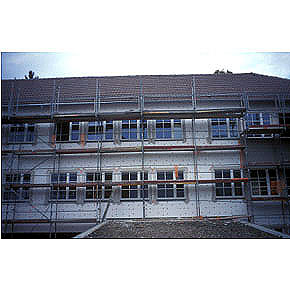Walls
Allthough the interior insulation of walls with polystyrene or mineral wool between some wooden or metal constructions including a vapour barrier might amount to less investment costs, because of the disadvantages described in "insulation material" most designers prefer to use external insulation at the exterior walls.In central Europe external insulation of massive walls is often realised by a thermal composite system. The insulation material is fixed to the wall (glued or by using anchors) and is in-situ covered by plaster. Thicknesses of 8 to 16 cm of insulation material are common. This will improve the U-value of the wall to appr. 0,3 resp. 0,2 W/mēK.Another system is the so-called overcladding. The mounted insulation material will stay behind a shell of wood, fiber, metall or even glass. To prevent moisture problems the system is mostly ventilated by using a small air gap between shell and insulation material. Overcladding systems provide similar U-

|

  
|
|
values as composite thermal systems, but tend to be more expensive. The advantage to the system is that the solid sheet cover ensures better protection of the insulation material against damage.In wooden constructions used in Northern climates the insulation can either be increased between the construction (then the sheeting of the inner or outer side has to be removed) or by additional insulation material, preferably on the outside.Solar walls are alternatives to traditional external post-insulation of walls with a southerly orientation where the solar radiation on the walls is used for heating the rooms behind and/or for reducing ventilation loss. Solar walls have been roughly divided into ventilated and unventilated solar walls. The principle in both cases is to cover the original facade with glass to form a layer of air between the glass and the surface of the wall, which is painted black for greater solar absorption. Solar radiation causes the temperatures on the wall surface and in the layer of air to rise. Depending on its construction, the high temperature can be used in different ways to reduce the heat loss of the rooms behind the solar wall.
|